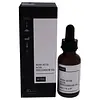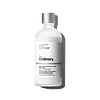What's inside
What's inside
 Key Ingredients
Key Ingredients

No key ingredients
 Benefits
Benefits

 Concerns
Concerns

 Ingredients Side-by-side
Ingredients Side-by-side

Water
Skin ConditioningLactococcus Ferment Lysate
Skin ConditioningGlycerin
HumectantEthyl Linoleate
EmollientHydroxyethyl Acrylate/Sodium Acryloyldimethyl Taurate Copolymer
Emulsion StabilisingHexanoyl Dipeptide-3 Norleucine Acetate
Skin ConditioningMyristoyl Nonapeptide-3
Skin ConditioningYeast Extract
Skin ConditioningSoy Amino Acids
Skin ConditioningBisabolol
MaskingPseudoalteromonas Exopolysaccharides
Skin ConditioningLecithin
EmollientSorbitan Isostearate
EmulsifyingIsohexadecane
EmollientPolysorbate 60
EmulsifyingPolyacrylate Crosspolymer-6
Emulsion StabilisingTrisodium Ethylenediamine Disuccinate
Sodium Salicylate
PreservativeCitric Acid
BufferingSodium Chloride
MaskingPotassium Sorbate
PreservativeSodium Benzoate
MaskingPentylene Glycol
Skin ConditioningEthoxydiglycol
HumectantPhenoxyethanol
PreservativeChlorphenesin
AntimicrobialWater, Lactococcus Ferment Lysate, Glycerin, Ethyl Linoleate, Hydroxyethyl Acrylate/Sodium Acryloyldimethyl Taurate Copolymer, Hexanoyl Dipeptide-3 Norleucine Acetate, Myristoyl Nonapeptide-3, Yeast Extract, Soy Amino Acids, Bisabolol, Pseudoalteromonas Exopolysaccharides, Lecithin, Sorbitan Isostearate, Isohexadecane, Polysorbate 60, Polyacrylate Crosspolymer-6, Trisodium Ethylenediamine Disuccinate, Sodium Salicylate, Citric Acid, Sodium Chloride, Potassium Sorbate, Sodium Benzoate, Pentylene Glycol, Ethoxydiglycol, Phenoxyethanol, Chlorphenesin
 Reviews
Reviews

Ingredients Explained
These ingredients are found in both products.
Ingredients higher up in an ingredient list are typically present in a larger amount.
Chlorphenesin is a synthetic preservative. It helps protect a product against bacteria in order to extend shelf life. In most cases, Chlorphenesin is paired with other preservatives such as phenoxyethanol and caprylyl glycol.
Chlorphenesin is a biocide. This means it is able to help fight the microorganisms on our skin. It is also able to fight odor-releasing bacteria.
Chlorphenesin is soluble in both water and glycerin.
Studies show Chlorphenesin is easily absorbed by our skin. You should speak with a skincare professional if you have concerns about using Chlorphenesin.
Learn more about ChlorphenesinCitric Acid is an alpha hydroxy acid (AHA) naturally found in citrus fruits like oranges, lemons, and limes.
Like other AHAs, citric acid can exfoliate skin by breaking down the bonds that hold dead skin cells together. This helps reveal smoother and brighter skin underneath.
However, this exfoliating effect only happens at high concentrations (20%) which can be hard to find in cosmetic products.
Due to this, citric acid is usually included in small amounts as a pH adjuster. This helps keep products slightly more acidic and compatible with skin's natural pH.
In skincare formulas, citric acid can:
While it can provide some skin benefits, research shows lactic acid and glycolic acid are generally more effective and less irritating exfoliants.
Most citric acid used in skincare today is made by fermenting sugars (usually from molasses). This synthetic version is identical to the natural citrus form but easier to stabilize and use in formulations.
Read more about some other popular AHA's here:
Learn more about Citric AcidPhenoxyethanol is a preservative that has germicide, antimicrobial, and aromatic properties. Studies show that phenoxyethanol can prevent microbial growth. By itself, it has a scent that is similar to that of a rose.
It's often used in formulations along with Caprylyl Glycol to preserve the shelf life of products.
Trisodium Ethylenediamine Disuccinate is used to help stabilize a product.
It is a chelating agent, meaning it helps prevent metal ions from binding to other ingredients. This prevents unwanted reactions in products. Metal ions can come into a product via the water ingredient. They are found in trace amounts and are not known to be harmful.
Water. It's the most common cosmetic ingredient of all. You'll usually see it at the top of ingredient lists, meaning that it makes up the largest part of the product.
So why is it so popular? Water most often acts as a solvent - this means that it helps dissolve other ingredients into the formulation.
You'll also recognize water as that liquid we all need to stay alive. If you see this, drink a glass of water. Stay hydrated!
Learn more about WaterYeast extract is a silky, clear liquid derived from yeast (usually Saccharomyces cerevisiae or Torula yeast).
This ingredient has plenty of skin benefits:
Bioferments of yeast and soy have been found to reduce hyperpigmentation at low levels.
Due to its fatty acid content, this ingredient may not be fungal-acne safe.
Learn more about Yeast Extract